Field Artillery and Infantry on the Western Front during the FIrst World War
- Home
- World War I Articles
- Field Artillery and Infantry on the Western Front during the FIrst World War
In August 1914, and again in November 1918, the Royal Field Artillery of the British army was fighting in partnership with the forward divisional infantry, directing accurate targeted fire onto enemy strongpoints to facilitate infantry objectives. For various reasons, both practical and doctrinal, this cooperation was partially lost, on the Western Front, in the intervening years. As a broad generalisation, when field artillery batteries were firing pre-ordained barrages at the behest of senior generals, their contribution to infantry success was limited, but when they were firing as directed by their own forward observation officers (FOOs), liaising with the forward infantry, their contribution to success was much greater.
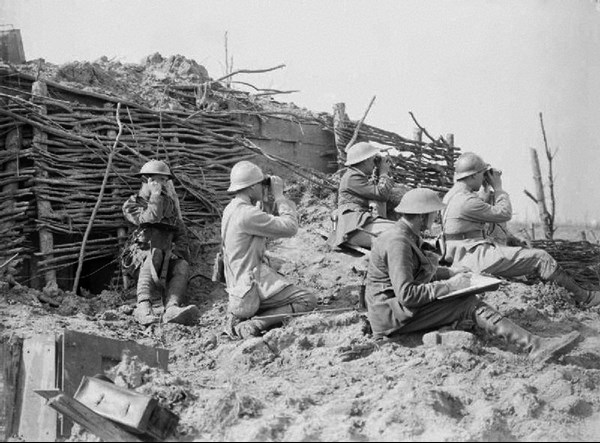
Above: British and French artillery observers Battle of Langemarck, 1917
This simplified guide to the changes in tactical deployment and command structure as it pertains to the field artillery is based on Rawlins’ excellent History of the Artillery. The theses written by Marble and Simpson are also good sources. All three emphasise that the subject cannot be understood without reference to Field Service Regulations (FSR).

FSR Part I Operations was a training document, binding on the British army, published in 1909 after five years of consensus led debate, based on academic analysis of annual military manoeuvres; and amended in the light of further conferences and manoeuvres right up to 1913. Key to the doctrine was acceptance of the concept that the Commander-in-Chief decided strategy. He should then direct his divisions into position and tell them what he wanted them to achieve. Divisional commanders were totally responsible for the tactical implementation of their chief’s plans, with their infantry and artillery working together to achieve his objectives. In the small British army of August 1914, this worked very well. All the artillery, including a single battery of sixty pounders per division, were deployed in support of infantry brigades, wholly directed by divisional commanders. The problems with this approach in a huge war were not immediately apparent, since the British army had very little heavy artillery.
But, even in 1914, both Army and Corps had a Commander Royal Artillery (CRA), a post which had not been conceived when FSR, Part II and its derivative, the Staff Manual 1912, which defined the staff structure of any expeditionary force, was written. As a consequence of this oversight, these CRAs were not on the General Staff, under the Chief of the General Staff (CGS) and had no right to issue orders to anyone. With artillery controlled at divisional level, guns and munitions being delivered to the front under the auspices of the Quartermaster-General (QMG), and the manning of artillery units being the responsibility of the Adjutant-General (AG), their duties were confined to offering advice to all three branches; and they had no supporting staff. They were designated Artillery Advisers (AAs) to reflect their lack of statutory responsibilities. But they were senior officers and determined to have an impact. Brigadier-General Henry Horne, CRA II Corps in 1914, soon did.
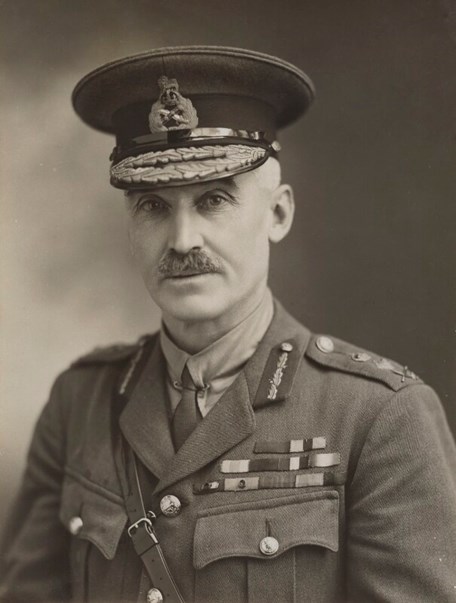
Above: General Henry Sinclair Horne (taken in 1917)
In reconnaissance before the Battle of Mons, Douglas Haig instructed Horne to ensure that the artillery of the 1st and 2nd Divisions cooperated in covering the Corps front, and that touch was made with II Corps artillery at Mons on his left. Horne’s intervention, tactfully suggesting modifications to initial divisional arrangements, was not FSR doctrine as rigidly defined but no senior officer of either division was the slightest perturbed. Smith-Dorrien’s II Corps also had a CRA, but he was incapacitated in a car crash just before the battle. Perhaps as a consequence, a major defect of Smith-Dorrien’s battle plan at Mons, happily not exploited by the enemy, was that the artillery on his second line, south of Mons, was in two parts, with a big gap at the junction of his two divisions. Horne continued his coordinating role, directing the rearguard retreat of I Corps on 24 August, careful to maintain touch between the 1st, 2nd and 3rd Division’s artillery, supported by the Horse Artillery of the 5th Cavalry Brigade. However, such was the confusion of the next three weeks of retreat that the importance of Horne’s intervention, at Haig’s direction, was overlooked. Over the next few months, a rag-tag of artillery reinforcements started to arrive, generally allocated to divisions.
Fast forward to January 1915. Somebody at General Headquarters (GHQ), probably Brigadier-General John Du Cane who became Artillery Adviser to French that month, realised that artillery could not be directed efficiently solely at divisional level.

Above: Lieutenant General Sir John Philip Du Cane
To paraphrase: ‘There has hitherto been far too much rigidity in this respect, …[not] conducive to the provision of efficient artillery support.’ ’The question of the command of the heavy guns …[is also] outstanding.’ ‘Each division has its divisional artillery and a small’ number of heavier guns, with ‘fire control decentralised.’ In an attack, it will be necessary to concentrate the fire of the heavy guns’ and ‘a Corps Artillery Commander with a Staff Captain and sufficient means of communication are necessary.’ He should ‘be termed the C.R.A.’ and should ‘command such portions of the artillery as not placed specifically under divisional commanders.’ ‘It will [sometimes] be desirable to place some of the artillery of one or both divisions directly under’ his orders.’
This was a sensible suggestion. The CRA as proposed would have joined the hierarchy of the CGS. Every senior officer in this command hierarchy had the right, under FSR, Part I (Operation)regulations, to order an immediate subordinate to release one or more of his units for him to direct as he wished. But in order to create these new posts, an amendment to the Staff Manual 1912 was required. This document added detail to the provisions of FSR Part II (Administration), which ensured that all general and administrative staffs should work in a uniform way, thus avoiding the problems that bedevilled the British army in South Africa at the turn of the century. Adhering closely to Part II, and handbooks based on it, had already proved its worth. Supply chains under the QMG, and personnel management under the AG, were both defined by it, and worked like clockwork in 1914 and thereafter. But this problem was in the third great arm of GHQ, the hierarchy of the CGS. An amendment to the Staff Manual 1912 was required to define a CRA within this hierarchy. For this, procedural approval was required from the Chief of the Imperial General Staff at the War Office, and then the new post could be published as a binding update in Army Orders. Du Cane had drafted many amendments to FSR in his career and was thoroughly aware of the process. Quite why Sir John French did not insist on this change is not clear.

Above: Sir John French
If these posts had been incorporated into the Regulations, there would have been a uniform command structure in place to direct the rapidly expanding heavy artillery and to rationalise the use of the field artillery during trench warfare. But it never happened. Probably the devil was in the detail, with the CGS, QMG and AG all raising objections to block the change. But the problems raised at the time did not go away.
During 1915, divisions controlled their own field artillery, in defence, with reference to FSR, Part I and Field Artillery Training 1914 (FAT).As Bowman and Connelly say, ‘the British went to war without a formalised method for infantry and artillery cooperation.’ But Travers is wrong to suggest that ‘pre-war cooperation between artillery and infantry was largely absent’. It is true that this cooperation was not formalised, and it is true that generals at Corps and GHQ level did not, in 1914, organise that cooperation. But the importance of constant liaison with the infantry, at sub-divisional level, was a key concept. FAT, which is based on FSR, agrees that the job of the field artillery was to support the movements of divisional infantry, and that ‘it is of the utmost importance that communication should be maintained between artillery and infantry commanders.’ But it is vague in defining the mechanics of that cooperation and concludes by saying that ‘the actual method by which this co-operation should be obtained will vary in accordance with the general nature of the operation’. There were no standing orders to formalise the structure of infantry artillery liaison, at any level. But, in 1914, it worked – within a division, at both brigade and battalion level. Liaison, on personal initiative, was the duty of every officer, as laid down in FSR, Part I.
So, in 1915, the regular divisions deployed their field artillery with professionalism, adhering to FSR. In August, Brigadier-General J. Rotton, was appointed CRA of the regular 7th Division, and issued orders on ‘artillery cooperation in defence.’ Paraphrasing: - ‘As a rule, one Artillery Brigade should be detailed to each Infantry Brigade. The Artillery Brigade Commander will be responsible for the defence of that front and have a telephone line to maintain close touch with the Infantry Brigadier whose front he supports. As far as possible, each Battalion front is covered by one or more Batteries. Each battery should appoint a Forward Observation Officer (FOO) whose duty is to assist the infantry by personal observation of the front, and by being a channel of communication between battery and battalion, communicating to his battery requests for Artillery assistance against targets, etc.
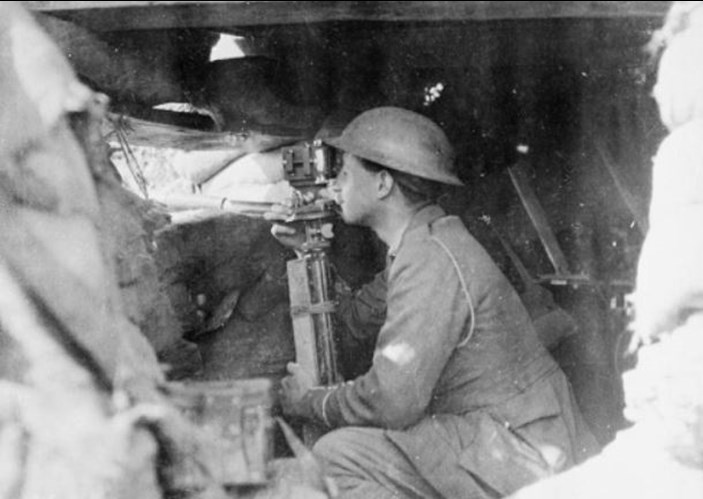
Above: An artillery Forward Observation Officer (IWM HU91352)
The necessary telephone lines…’ should be set up. ‘In addition, the FOO should be able to listen in to the Infantry telephone system; and there should be an additional unmonitored wire from the front-line trench to battery for use in an emergency.’ At night, the FOO should sleep in Battalion Headquarters. Every battery should register points on, or just behind, the enemy front lines, and all guns aligned on these targets at night, so that artillery support could be provided quickly in the event of a surprise attack. This sophisticated template ensured that liaison pathways were clearly defined; and that any artillery response to an attack would be commensurate to the threat posed. Rotton was doing no more than defining his version of best practice.
Some attempt had been made to define this by means of Central Distribution Service (CDS) pamphlets, later designated Stationery Service (SS)updates, which started providing tactical and other advice, based on FSR, in late 1914. The first two, Notes from the Front, Parts I and II, emphasise the importance of infantry artillery cooperation, as defined in FSR, but fail to add detail. But Part III, issued in February 1915, addresses the issue in detail. The FOO ‘is a direct link for co-operation between the infantry and the guns behind them. Usually, the best place for this officer in a protracted engagement is in the infantry trench itself.’ ‘The company commander in the trench is often in telephonic communication with the battalion commander and if the artillery telephone be placed in the next “dug-out” to the infantry telephone, messages can be sent direct from the battalion to the battery commander.’ It further recommends that the FOO shares the detail of ‘ranged’ points with the local infantry commander, so that he can inform the battery direct if he wants one of these points attacked. Later in the document, it goes on to suggest ‘best practice’ variations in wire lay-out for the division generally, suggesting doubled wires in all exposed areas. A follow-up document, CDS 5; Trench Warfare, Notes on Attack and Defence, also from February 1915, stresses the need for this cooperation, not just in defence, as defined in FSR.
But the subtleties of this guidance were too much for the new divisions. On arrival on the front line in France in April 1915, the ‘new’ 47th Division issued standing orders on countering an attack, a copy of which is in the Artillery Diary. Again paraphrasing: - ‘The front line is to be held at all costs. At the first sign of an attack, our artillery will bombard the enemy’s trenches. To open fire satisfactorily the closest touch must be kept between the forward trenches and the batteries by a pre-arranged signal. Red rockets have been provided for this purpose. Counter-attack must be immediate. Commanders are to have a plan ready for all eventualities. Infantry Brigade Commanders will consult with officers commanding the supporting artillery. ’Artillery is not mentioned in defining ‘general principles’ of defence, but it goes on to say that ‘close cooperation with the infantry, the support of whom is their primary function, is essential for all battery officers. Their observing stations should be made known to the infantry and their requirements for observation explained. Plans for action in the event of attack, prepared by Infantry Brigade Commanders, should include details of artillery support. The CRA is responsible for complete and accurate registration.’ In this war diary copy, there is a pencilled addition, ‘? Telephone Communications.’ It is a fair question. The liaison described falls far short of that defined in FSR, FAT, and Notes from the Front. Battalion commanders are not in the loop, and lines of responsibility for the intensity of any artillery response are not clear. The FOO, in his observation post, is not directed to liaise with front line infantry, and is useless at night. This guidance does not, in a number of other respects, conform with either common sense, or FSR, but as a basis for improvement in the light of experience it is a reasonable starting point. Enlightened artillery and infantry officers would have learnt much from taking over the positions of regular units when they found sophisticated communications in place.
And at least they had guidance. There is no record of any standing orders for the 35th Division, the ‘Bantams’, when they arrived, belatedly, at the front in 1916. They were, arguably, the least well-prepared of any division sent out to France, and very soon after their arrival in the line, in May 1916, a surprise incursion at night resulted in the capture of 38 men. As their FOO cowered helplessly in his post, the artillery responded by bombarding their own forward trenches, probably after the departure of the raiders.
This was in defence, the easiest part of the field artillery brief. Major-General Noel Birch, Artillery Adviser to Douglas Haig, who succeeded Du Cane as Artillery Adviser at GHQ in December 1915, was still saying, in July 1916, that ‘no General Staff, except a Divisional one, is officially constituted to fight a battle.’
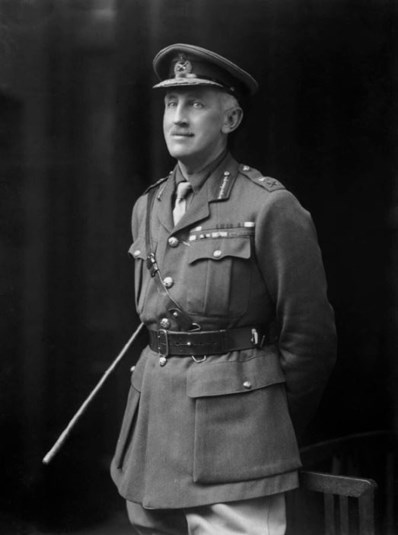
Above: Sir (James Frederick) Noel Birch
This was certainly the legal position on a strict interpretation of FSR. But from 1914, it was never as simple as that. Staff were first posted to the GHQ Artillery Adviser in 1914, when heavy guns started to arrive. One of his staff was from the Quartermaster-General’s (QMG) branch, reflecting his role in advising on the provision of guns and munitions. He was also advising the Adjutant-General (AG) branch on personnel and billeting. But with no formal place in the administrative hierarchy, his interventions were not friction-free; and it got worse in 1915, when all his, and all new staff appointed to his equivalents at Corps, were graded not as General Staff (GS), but as AG staff, implying that he had no operational role. By mid to late 1915, this did not reflect reality on the ground. As Birch put it in July 1916, and it was as true then as it had been a year earlier, the position was that the ‘Artillery Adviser, though it is distinctly laid down that he is neither a Staff Officer nor a Commander, has become a fighting officer, and has had to assume a position that he …is not entitled to. He allots his guns, controls his ammunition, supervises the artillery fights, etc.’‘Corps Artillery Commanders’ have ‘already assumed these duties …to a great extent …through the personality of individuals …and not from GHQ direction.’
So, what did this mean for field artillery officers in the divisions? Part I (Operations) lays down that field batteries were integral to the protection of the forward infantry, and should fire at the behest of local commanders, in both offence and defence. And it also demands that every officer, on active service, should, at all times, know who his immediate superior is, and should respond to operation orders only from that superior. But corps control of the field artillery in 1915 ‘crept’ up on the divisions rendering both these concepts redundant, to the fury of regular officers. There were three main reasons.
First, some senior officers were temperamentally unable to restrain themselves from micro managing their subordinates, despite the fact that doing so was a severe breach of FSR, Part I. This was not new. Haig, in 1914, uniquely amongst infantry generals of that year, issued orders direct to infantry brigades, with less than stellar consequences. And he turned a blind eye when other senior officers, most notably Hubert Gough, breached Part I in the same way.
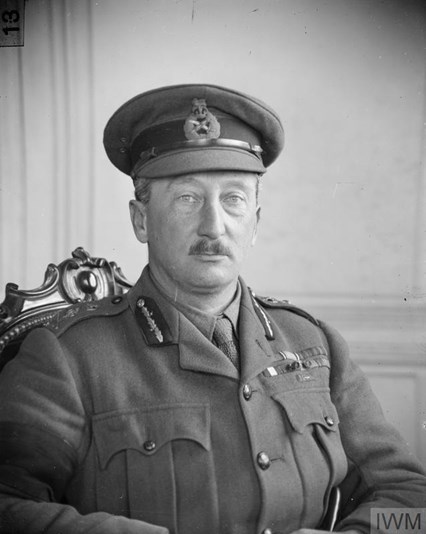
Above: General Sir Hubert Gough (IWM)
Many Artillery Advisers, already cast aside from strict FSR legality, started, with more justification, in newer divisions whose officers did not possess the necessary skills, to issue orders direct to artillery brigades, or even batteries.
And the field artillery was a special case. To understand this, it is necessary to address FSR, Part II Administration, remembering that the staff of the artillery advisers were from the AG branch. Part II describes an administrative bureaucracy, modelled on civilian enterprises. High-ranking commanders of various directorates issued instruction direct to the level of implementation. Thus, a general, for instance directing transport, might issue an order straight to a captain responsible for, say, railway timetabling. In this system of command, officers gave orders to, or accepted orders from, any officer in their hierarchy. The staff of the Artillery Advisers were used to this administrative command structure, in compliance with Part II. So, when, in 1915, corps started issuing orders restricting ammunition use, an issue that was administrative, within the remit of the QMG, they directed them to the end-user, the battery. The operational consequences, covered by Part I, were ignored. It was then but a short step for staff at corps to start issuing firing schedules for the front-line batteries of their divisions, failing to understand the doctrinal indignation this caused in regular front line officers observing Part I, which demanded that they should use their initiative, taking into account ammunitions stocks, to support their front line as best they could.
But worse than this, FSR Part II Administration was intended to ensure uniformity in senior staff structures. Divisions moved between corps, and divisional artillery commanders found that the staff of every corps had a different expectation of how they should relate, depending on how firmly their Artillery Adviser wanted to take control. So, through 1915, in large offensive operations, firing was increasingly directed at corps level, but might, or might not, be delegated to divisions in smaller attacks. In quiet sectors of the line, firing was bureaucratically limited by orders from corps, justified by shell shortages, often forbidding opportunistic shooting and demanding that every shell be accounted for within a corps artillery plan. But in defence, when a trench line was attacked, CRA Division remained responsible for planning the local artillery response, as already described. Birch, who took over as Artillery Adviser at GHQ in December 1915, confirmed this, as late as July 1916, saying that ‘the Divisional General [should retain] responsibility for the defence of any portion of the line.’ As far as the field artillery were concerned, they had to follow FSR, Part I in some circumstances, but not in others.
On 28 July 1915, after the Battles of Festubert and Givenchy, Du Cane addressed another note to French’s CGS on ‘Artillery Command and Organisation,’ pointing out further problems in managing both heavy and light artillery. ‘The IV Corps’ Operations (in May and June 1915) demonstrated the need of an Artillery Commander to coordinate the action of the Artillery of the Corps.’ In recent battles, ‘the C.R.A. 7th Division “exercised command” over a very large concentration of guns,’ from several divisions, all crowded into a small sector. This unsatisfactory situation, he suggested, could be resolved by giving Corps Artillery Advisers ‘powers of command’, particularly over the Army heavy howitzer groups. But this letter ignored the fact that they had, albeit inconsistently, already taken ‘powers of command.’
So, when on receipt of Du Cane’s letter in July 1915, GHQ threw open the debate on the status of CRA Corps to the three army commanders, it was too late to agree a consensus, especially when, in August 1915, GHQ allowed First Army to establish a Heavy Artillery brigadier-general with attached staff within its operational General Staff, making it even more difficult to fit their more senior Artillery Adviser into the hierarchy. Rawlins describes the contradictory GHQ orders that further exacerbated the legal uncertainty of the Artillery Advisers’ role as the various corps revised their similar, but not uniform, artillery arrangements. (The term Artillery Advisers is used here, despite changing official designations, because these failed to reflect any change in their legal, as opposed to de facto, status.)
When Haig became Commander-in-Chief in December 1915, Birch echoed Du Cane in asserting that ‘corps must command their own artillery and …have the instrument and necessary machinery to do so.’ But the main problem at this stage of the war was the desperate inexperience of the new divisions. From 1915 to 1917, artillery brigades operated to their level of competence, a fact made explicit, somewhat belatedly, in Kiggell’s paper on the Training of Divisions for Offensive Action (SS 109) of May 1916, which hardly mentions the artillery. ‘Officers and troops generally do not now possess that military knowledge arising from a long and high state of training which enables them to act promptly on sound lines in unexpected situations. They have become accustomed to deliberate action based on precise and detailed orders, ’although he was quick to add that ‘the general principles laid down in our training manuals hold good, and special attention is directed to [relevant] Chapters in’FSR, Part I’ Operations. There is a yawning chasm between the advice given in the pamphlet, and that given in FSR, Part I. It seems that Kiggell recognised this, and SS 109 was soon followed by SS 135, Instructions for the Training of Divisions for Offensive Action, issued in December 1916.
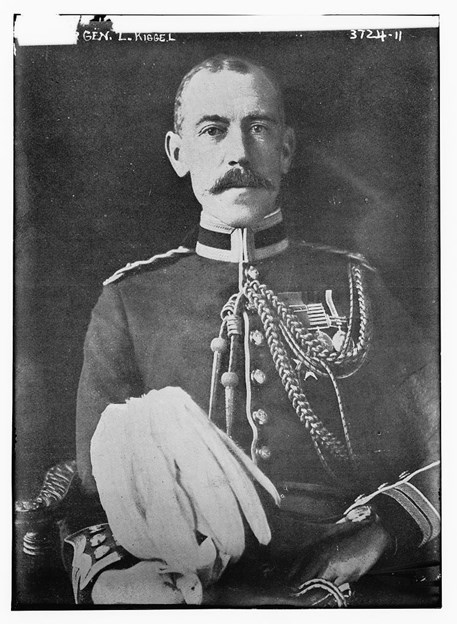
Above: Lt Gen Sir Launcelot Edward Kiggell
This dispensed with FSR, Part I altogether, as it pertained to the artillery. It said that the artillery of all divisions, regardless of competence, should accept ‘detailed instructions’ from the ‘G.O.C., R.A. of the Army’, utilising ‘all the resources of the Corps.’ It banned infantry liaison with artillery at battalion level, and placed procedural obstacles in the way of it even at brigade level.
Just because SS 135 was issued does not mean it was observed.
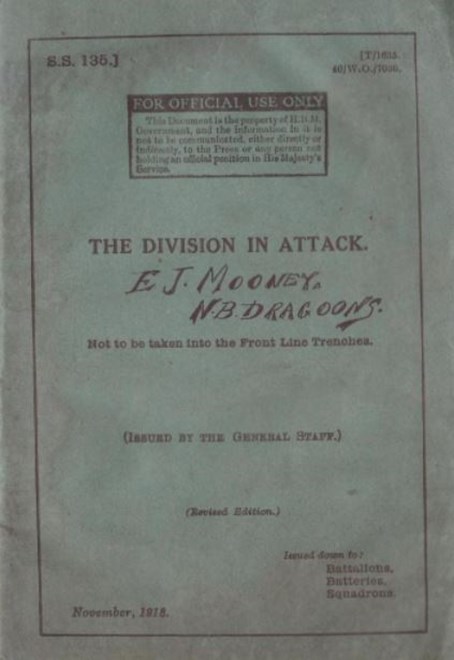
Above: SS 135
There is no evidence of its systematic implementation, and very few regular officers were comfortable with a total rejection of engrained FSR, Part I concepts. Subsequent pamphlets, such as SS 148, Forward Inter-communication in Battle, of March 1917, not credited to GHQ, firmly restated them. So, it is impossible to generalise on infantry artillery cooperation at divisional levels during the Somme; just as it is impossible to generalise on the operational command hierarchy between corps, via division, to any particular battery. Both depended on the personal command ‘ethos’ which emanated from the army, corps or divisional commanders in that hierarchy, and the interaction between them.
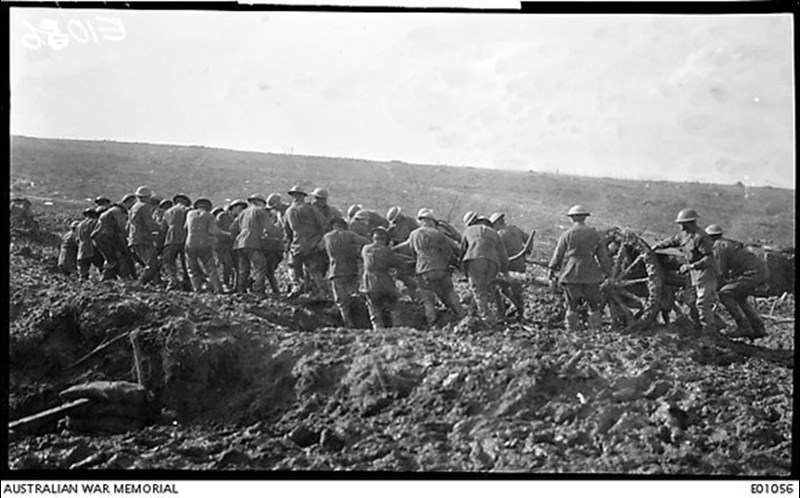
Above: Moving guns during 3rd Ypres (AWM)
It is perhaps easiest to illustrate this with an extreme example. Under Gough, at the Battle of Passchendaele, a field artillery commander wrote in his war diary that his ‘brigade did a standing barrage and smoke screen. No indication given to the artillery on this front what the infantry objectives were. Seems a mistake not to give the artillery some idea of what is going on.’
There was no local liaison at all. Gough was sacked, and Plumer took over the management of the battle. Within eight weeks, this same officer was up at Polygon Mound, meeting with his forward infantry liaison officer, and trying to locate a reasonable base for his FOO and rocket piquet officers to establish themselves. In November 1916, Gough, taking SS 135 to its logical end-point, suggested abolishing divisional artillery altogether. But Plumer was saying ‘barrage plans by higher authority does not absolve divisional commanders from full responsibility to obtain a barrage meeting all their requirements.’ Tattersfield briefly describes how the main corps commanders fall in this spectrum of views at the Somme, and Hughes usefully describes how Plumer conducted his battle at Messines Ridge, basing his artillery plan on a pragmatic version of FSR, Part I.
But before this doctrinal free-for-all became really damaging, GHQ, in late 1916, proposed a fundamental reorganisation of the field artillery. Many problems had come to light during the prolonged offensive operations of the Somme. Field artillery brigades often remained in situ as the divisional infantry who were fighting in front of them rotated into rest. Corps tried to organise the artillery support needed to continue the offensive. But by issuing firm orders on barrage plans, the work of FOOs was largely nullified; and, due to the fluidity in positions and slow transmission of orders, many barrages fired were ineffective or worse. There was no mechanism by which infantry commanders could adjust barrages which were hitting the wrong targets. Additionally, some artillery brigades were so inexperienced, they were more danger to their friends than their enemies, fit only to fire off mindless barrages, unused even to working with FOOs. Too many batteries were third rank, unwanted by the commanders of the better divisions. And brigades were not uniform, some being very small, or equipped with obsolescent guns.
Approved by the War Office in December 1916, the reorganisation that resulted was startling in its scale and effectiveness. Over four months, all field artillery brigades on the Western Front were converted to three 18 pounder batteries of six guns, and one battery of 4.5” howitzers, usually four guns due to their more limited availability.
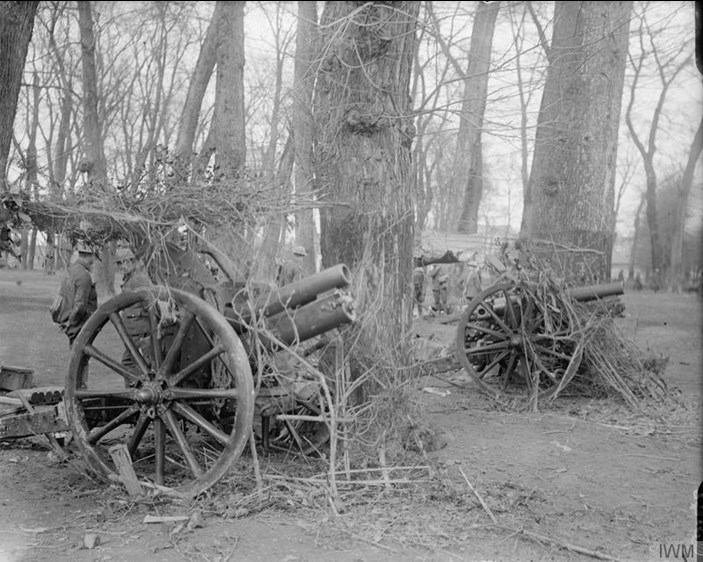
Above: Camouflaged British 4.5 inch field howitzers at Arras April 1917 (IWM Q 5412)
Many brigades were broken up, with obsolescent guns, and some obsolescent officers, retired. Useful guns, in sixes, fours or twos, were relocated to equip the remaining brigades. Two enlarged, rather than four small, brigades were allocated to each division, and the surplus, some forty of them, allocated to Army reserves. These ‘Army Brigades’ were immediately given to corps who used them to reinforce divisional artillery in sectors where artillery concentration was needed. They stayed in situ when the two divisional artillery brigades rotated into rest with the rest of their division. The men who commanded these new consolidated field artillery brigades, be they divisional or army, had mostly been junior officers in 1914, well versed in FSR. Most of them were, by this stage, very competent. Not only were standards raised in less experienced batteries, but the arrival of a good Army Brigade on a sector controlled by a less experienced division encouraged an improvement in standards of command, self-protection, battery siting and forward liaison. The reverse was also true. The regular officers in army brigades did not like losing their divisional identity, but there is no doubt that the reforms stimulated a marked improvement in the professionalism of the Field Artillery.
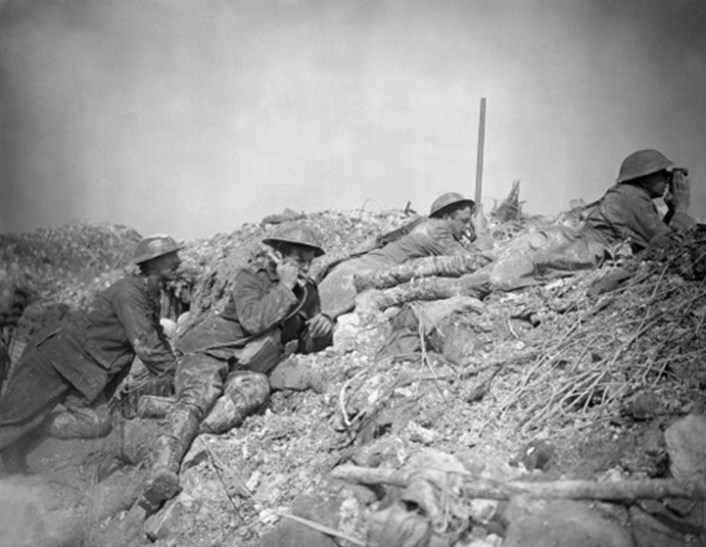
Above: A Royal Artillery FOO reporting on the accuracy of fire on the Arras sector, 8 April 1917
The problem of artillery command in any one sector was solved by the more widespread adoption of groups. This was not new. It was a command structure used by the CRA, 5th Division at Mons in 1914. Senior artillery brigade colonels directed all the forward artillery in their sector, regardless of the nominal hierarchy of the batteries involved. This caused no doctrinal conflict in battery commanders. FSR simply demanded that any officer on campaign determine who he was answerable to, and then obey orders from him. The group commander was responsible for liaising with the infantry brigadier for that sector, and since most were regular officers, familiar with FSR, they were generally assertive in establishing forward liaison, along the lines of SS 148.This trend was given a boost by the defensive battles of the German Spring Offensive of 1918. Even senior generals agreed that close liaison between field artillery and forward infantry was vital in repelling attacks on defensive positions. Direction of field artillery brigades, even in attack, moved forward to infantry brigade and division, and generally stayed there.

Above: A sergeant apparently calculating gun elevations in a trench
By the more open battles of 1918, infantry brigades and artillery brigades in the best divisions were cooperating as closely as they had in the battles of 1914, accepting strategic instruction, but not tactical direction from generals at corps and army level. They were, once again, following the detail of FSR, Part I Operations. This is confirmed by the revision of SS 135, Instructions for the Training of Divisions for Offensive Action, issued in November 1918, reflecting best practice. It is surprising that this was not given a new SS number, so different is it from the original. But by this stage of the war, the concepts enshrined in Part I, honed by new technology and increased sophistication, were being followed by all competently commanded units at divisional level and below. As Haig belatedly acknowledged in a letter to Henry Wilson in September 1918, to ‘a steady adherence to the principles of our Field Service Regulations, Part I, are our successes to be attributed.’
But few modern historians even mention FSR in their studies of tactics or command structure on the Western Front. There is no academic analysis of it in print, its origins are widely misunderstood, and its impact on the regular officer corps of 1914 severely underestimated. As both Marble and Simpson acknowledge, and Rawlins confirms, the development of the field artillery between 1914 and 1918 cannot be understood without reference to it. Nor can that of the infantry, but that is another matter!
Article by David Keable-Elliott, April 2022.
Detailed referencing is available on request. Main primary and secondary sources as follows:
- Brevet-Colonel Stewart William Hughes Rawlins, History of the Development of British Artillery in France 1914-1918, (Unpublished private paper, 1918)Accessed 8 April 2022 at https://www.theogilbymuster.com/1162.1.
- Field Service Regulations, Part I, Operations, 1909, Reprinted with Amendments 1912, (London, General Staff War Office, 1912)
- Field Service Regulations, Part II, Organisation and Administration, 1909, Reprinted with Amendments 1913, (London, General Staff War Office, 1913)
- Field Artillery Training, (London, General Staff, War Office, 1914)
- The National Archives, various war diaries.
- William Sanders Marble, “The infantry cannot do with a gun less: the place of the artillery in the BEF, 1914-1918, (Ph.D. thesis, University College, London, 1998)
- Andrew Simpson, “The Operational Role of British Corps Command on the Western Front, 1914-1918” (Ph.D. thesis, University College, London, 2001)
- Timothy Bowman and Mark Connelly, The Edwardian Army, Recruiting, Training and Deploying the British Army, 1902-1914, ([2012] Oxford Scholarship Online, 2012)
- Tim Travers, The Killing Ground, The British Army, the Western Front & Emergence of Modern War, 1900-1918, ([1987] Pen and Sword, Barnsley, 2009)
- Jackson Hughes, “The Monstrous Anger of the Guns, The Development of British Artillery Tactics 1914 to 1918” (Adelaide, Australia, PhD Thesis, 1992)
- David Hutchison, The Young Gunner: The Royal Field Artillery in the Great War, (Kibworth Beauchamp, Leicestershire, Matador Press 2016). Written by the author.
- David Hutchison, Mons, an Artillery Battle, (Helion Press, Warwick, 2018) Written by the author.
- David Tattersfield, “British Corps Commanders in the Great War” Western Front Association website, uploaded 17/3/2022.
- Chris Baker, Batteries and Brigades of the Royal Field Artillery - The Long, Long Trail (longlongtrail.co.uk) Accessed April 2022.
- Central Distribution Service (CDS) and Stationery Service (SS) pamphlets, with thanks to A Rankin, https://www.greatwarforum.org/topic/288345-central-distribution-section-cds-and-stationery-service-ss-pamphlets-available-online/





